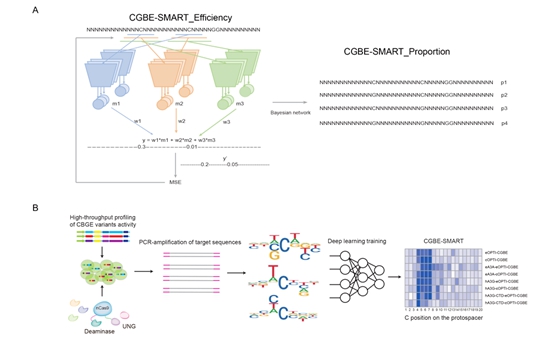Optimization of C-to-G Base Editors with Sequence Context Preference Predictable by Machine Learning Methods
Previous reports have shown that C-to-G transversion could be achieved by replacing the uracil-DNA glycosylase inhibitor (UGI) of a CBE with a uracil-DNA glycosylase (UNG), while these C-to-G editors showed efficient editing at limited target sites and provided few rules for efficient C-to-G editing. However, the sequence context affecting editing outcome largely remains unclear.
Recently, a research article entitled “Optimization of C-to-G base editors with sequence context preference predictable by machine learning methods” has been published in Nature communications by Dr. Zuo Erwei’s research group from the Agricultural Genomics Institute at Shenzhen, Chinese Academy of Agricultural Sciences (AGIS, CAAS) with Dr. Sun Yidi’s research group from the Institute of Neuroscience, CAS Center for Excellence in Brain Science and Intelligence Technology, Chinese Academy of Sciences, Shanghai, China (CEBSIT, CAS). In this paper, the authors engineered C-to-G BEs of high efficiency and fidelity, with the sequence context predictable via machine-learning methods.
By changing the species origin and relative position of uracil-DNA glycosylase and deaminase, together with codon optimization, the authors obtain optimized C-to-G BEs (OPTI-CGBEs) for efficient C-to-G transversion. The motif preference of OPTI-CGBEs for editing 100 endogenous sites is determined in HEK293T cells. Using a sgRNA library comprising 41,388 sequences, the authors develop a deep-learning model that accurately predicts the OPTI-CGBE editing outcome for targeted sites with specific sequence context. These OPTI-CGBEs are further shown to be capable of efficient base editing in mouse embryos for generating Tyr-edited offspring. Thus, these engineered CGBEs are useful for efficient and precise base editing, with outcome predictable based on sequence context of targeted sites.
Dr. Zuo from AGIS and Dr. Sun from CEBSIT supervised the project as the co-corresponding authors. Yuan Tonglong, Yan Nana, Zheng Jitan, Li Nana, Liu Jing from AGIS and Fei Tianyi, Meng Juan from CEBSIT contributed to this work equally as the co-first authors of the paper.
This study was supported by the National Natural Science Foundation of China (31922048), Central Public-interest Scientific Institution Basal Research Fund to E.Z. and China Postdoctoral Science Foundation (2020M670545)
More details about the paper could be found with the link below: https://doi.org/10.1038/s41467-021-25217-y

By Yuan Tanglong (yuantanglong@caas.cn)
-
 Apr 18, 2024Opening Ceremony of the Training Workshop on Wheat Head Scab Resistance Breeding and Pest Control in Africa Held in CAAS
Apr 18, 2024Opening Ceremony of the Training Workshop on Wheat Head Scab Resistance Breeding and Pest Control in Africa Held in CAAS -
 Apr 03, 2024IPPCAAS Co-organized the Training Workshop on Management and Application of Biopesticides in Nepal
Apr 03, 2024IPPCAAS Co-organized the Training Workshop on Management and Application of Biopesticides in Nepal -
 Mar 28, 2024Delegation from the School of Agriculture and Food Science of University College Dublin, Ireland Visit to IAS, CAAS
Mar 28, 2024Delegation from the School of Agriculture and Food Science of University College Dublin, Ireland Visit to IAS, CAAS -
 Mar 25, 2024Director of World Food Prize Foundation visited GSCAAS
Mar 25, 2024Director of World Food Prize Foundation visited GSCAAS -
 Mar 20, 2024Institute of Crop Sciences (ICS) and Syngenta Group Global Seeds Advance Collaborative Research in the Seed Industry
Mar 20, 2024Institute of Crop Sciences (ICS) and Syngenta Group Global Seeds Advance Collaborative Research in the Seed Industry
